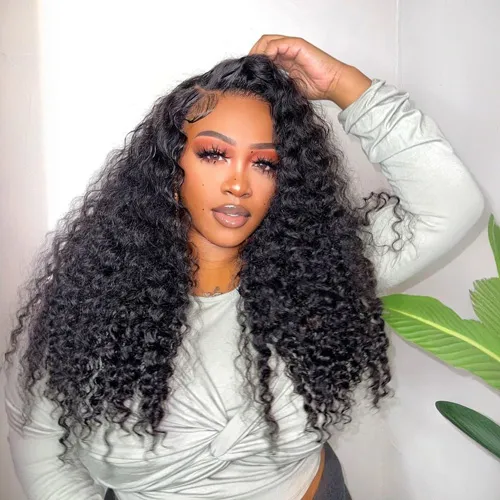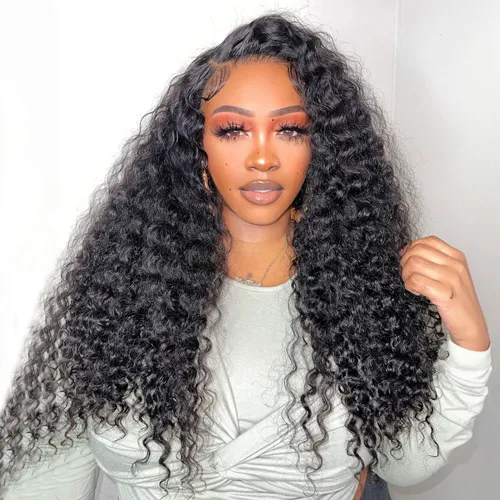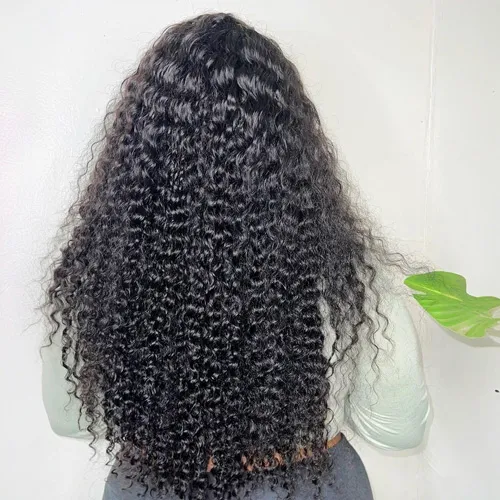How Do You Maintain A Deep Wave Wig?
Maintaining a deep wave wig requires a careful approach to ensure it stays looking as beautiful and vibrant as the day you first wore it. Deep wave wigs, with their tight and voluminous curls, need specific maintenance routines to keep their unique pattern without becoming frizzy or losing their definition. This article will walk you through the essentials of deep wave wig maintenance, covering everything from daily care tips to deep conditioning and proper storage techniques. By the end, you’ll have a thorough understanding of how to keep your deep wave wig in pristine condition.

Daily maintenance.
Daily maintenance of a deep wave wig is crucial to preserving its appearance and longevity. This type of wig, known for its voluminous curls and texture, requires a bit of extra attention compared to straight or lightly wavy wigs. Here’s a detailed breakdown of daily maintenance steps to keep your deep wave wig looking its best.
1. Gently detangle.
Tools needed: Use a wide-tooth comb or a special wig brush designed for curly textures. These tools help prevent snagging and minimize breakage.
Technique: Always start detangling from the ends and gradually work your way up to the roots. This method reduces shedding and prevents damage to the curls. For tighter curls or more delicate wigs, using your fingers to detangle can also be effective and gentle.
2. Moisturize and hydrate.
Products: Opt for lightweight leave-in conditioners or sprays specifically formulated for curly hair wigs. These products help maintain moisture without weighing down the hair.
Application: Lightly spritz the wig with water before applying any product. This helps distribute the product more evenly. Apply the leave-in conditioner or moisturizing spray sparingly and evenly throughout the wig, focusing on areas that tend to dry out faster.
3. Refresh the curls.
Curl revival: If the curls begin to look flat or lose their definition, use a curl-enhancing spray or mousse. Scrunch the product gently into the curls to revive their bounce and shape.
Avoid heavy products: Steer clear of heavy oils or styling creams that can build up and weigh down the wig. These products can also attract dust and lint, leading to a need for more frequent washing.
4. Protect from heat and sun.
Sun exposure: When outdoors, try to minimize the wig’s exposure to direct sunlight, which can fade the color and dry out the hair. Wearing a hat or scarf can provide protection without compromising the curls.
Heat styling: Avoid using heat styling tools daily. If you must reshape or smooth some curls, use a diffuser attachment on a low heat setting, and always apply a heat protectant first.
5. Nighttime care.
Before bed: To prevent tangling and frizz, gather the wig into a loose ponytail or braid. Covering the wig with a silk or satin bonnet can also help maintain the curls and reduce friction, which can cause breakage.
Silk or satin pillowcase: If you’re wearing the wig to bed, a silk or satin pillowcase can provide an extra layer of protection against tangling and matting.
Daily maintenance routine.
Morning: Gently detangle and moisturize. Refresh curls as needed.
Throughout the Day: Protect the wig from sun and environmental damage.
Evening: Detangle gently, apply light moisture, and prepare for bed with appropriate protective gear.

Washing your deep wave wig.
Washing your deep wave wig is a crucial aspect of its maintenance, ensuring that it remains clean, vibrant, and free of product buildup. This process, when done correctly, can rejuvenate the curls and extend the lifespan of your wig. Here’s a comprehensive guide to washing your deep wave wig properly.
1. Frequency of washing.
Human hair wigs: Wash every 2-3 weeks or when there is noticeable product buildup.
Synthetic wigs: Less frequent washing is required; once every 4-6 weeks is typically sufficient, depending on usage and exposure to environments.
2. Pre-wash preparation.
Detangle gently: Before washing, carefully detangle the wig using a wide-tooth comb or your fingers, starting from the tips and gradually working towards the roots to minimize breakage.
Rinse with water: Rinse your wig under lukewarm water in a downward motion, ensuring that the water flows from the roots to the ends to avoid tangling.
3. Washing steps.
Shampoo: Apply a sulfate-free shampoo specifically designed for curly or textured hair. Distribute the shampoo throughout the wig gently, in a downward stroking motion. Avoid scrubbing or bunching up the wig, as this can cause tangles.
Conditioning: After thoroughly rinsing out the shampoo, apply a generous amount of a moisturizing conditioner formulated for curly hair. Use your fingers to detangle the wig gently as you distribute the conditioner through the curls. This step helps to hydrate the hair, enhance the curl pattern, and reduce frizz.
Rinse: Rinse the conditioner out with lukewarm water, ensuring all the product is removed. It’s essential to rinse thoroughly to prevent product buildup, which can weigh down the curls.
4. Post-wash care.
Drying: Gently squeeze out excess water with a towel, avoiding wringing or twisting the wig, as this can damage the curl pattern. Lay the wig flat on a dry towel and let it air dry completely. If you’re in a hurry, you can use a hairdryer with a diffuser attachment on a low heat setting, but air drying is preferred to maintain the integrity of the curls.
Detangling: While the wig is still damp, gently detangle it again using a wide-tooth comb or your fingers, starting from the ends and working your way up. This step helps ensure the curls dry with a defined shape.
Styling: Once the wig is dry, you may use lightweight products to enhance the curls or control frizz. Avoid heavy oils and creams that can weigh down the hair. A light mist of leave-in conditioner or curl refreshing spray can help revive the wig’s bounce and shine.

Tips for maintaining deep wave curls after washing.
Curl definition: To enhance the curl pattern, apply a curl defining cream or mousse to the damp wig, scrunching gently to encourage curl formation.
Avoid brushing: Never brush your deep wave wig when it’s dry, as this can disrupt the curl pattern and cause frizz.
Night protection: Sleep with a silk or satin cap or use a silk pillowcase to prevent the wig from tangling and frizzing overnight.
Drying your deep wave wig.
Drying your deep wave wig properly is crucial for maintaining its beautiful curl pattern and ensuring its longevity. Incorrect drying methods can lead to frizz, tangles, and even damage to the wig fibers, whether natural or synthetic. Here’s a detailed guide to drying your deep wave wig effectively, preserving its natural beauty and texture.
a. Air drying: The best method.
1. Gently blot water: After washing, carefully blot excess water from the wig using a soft, absorbent towel. Avoid rubbing or wringing the wig, as this can disrupt the curl pattern and cause frizz.
2. Use a wig stand: Place your deep wave wig on a wig stand. A stand not only helps the wig to dry evenly but also maintains its shape and volume. If you don’t have a wig stand, a large, round object like a foam head can serve as a good alternative.
3. Shape the curls: Gently finger-comb or use a wide-tooth comb to shape the curls and remove any tangles. If you prefer, apply a light, curl-enhancing product to help define the curls as they dry. Ensure that you distribute the product evenly, focusing on areas that tend to frizz.
4. Allow to air dry: Let the wig air dry naturally. Depending on the density of the wig and the ambient temperature, this may take several hours or even overnight. Avoid the temptation to speed up the drying process with heat, as air drying is the gentlest method and helps preserve the integrity of the curls.
b. Using a hair dryer with a diffuser.
If you’re in a rush and need to dry your wig faster, using a hair dryer with a diffuser attachment can be a safe alternative, provided you use it correctly.
1. Attach the diffuser: Make sure the diffuser attachment is securely attached to your hair dryer. The diffuser helps to evenly distribute the airflow, reducing frizz and maintaining the curl pattern.
2. Use low heat: Set your hair dryer to a low heat setting. High temperatures can damage the wig, especially if it’s made of synthetic fibers, which can melt or become frizzy under excessive heat.
3. Gentle drying: Hold the dryer at a distance from the wig, allowing the diffused air to gently dry the curls. Move the dryer around to ensure even drying, but avoid focusing on one area for too long to prevent heat damage.
4. Cool shot: Once the wig is nearly dry, use the cool shot button on your dryer (if available) to blast the wig with cool air. This helps to seal the cuticles, enhance shine, and set the curls.
c. Additional tips.
Do not rub: When using a towel to blot excess water, press gently and do not rub the hair, as rubbing can cause frizz and disrupt the curl pattern.
No direct sunlight: While air drying, avoid placing the wig in direct sunlight. Sun exposure can fade the color and dry out the hair fibers, leading to brittleness.
Evening wash routine: If possible, wash your wig in the evening and let it air dry overnight. This minimizes the need to use a hair dryer and reduces the risk of going out with a damp wig.
Styling your deep wave wig.
Styling your deep wave wig is a creative process that allows you to customize your look while maintaining the integrity of the wig’s natural curl pattern. Whether you’re aiming for a subtle enhancement or a dramatic transformation, understanding the right techniques and products is crucial.
a. Embrace and enhance the natural curls.
1. Use the right products: To enhance the natural curl pattern of your deep wave wig, opt for lightweight, water-based styling products. Mousse, curl defining creams, and sprays can add definition and shine without weighing down the curls.
2. Application technique: Apply your chosen product evenly throughout the damp wig, using your fingers to gently work it through the curls. This helps to maintain the wig’s volume and definition. Avoid heavy oils or thick creams that can cause buildup and dull the hair’s natural luster.
3. Diffuse for volume: If you need to dry your wig after applying styling products, use a hairdryer with a diffuser attachment on a low heat setting. Gently cradle the curls in the diffuser to dry them while boosting volume and definition.
b. Altering the curl pattern temporarily.
1. Flexi rods or curlers: For tighter or more defined curls, consider using flexi rods or curlers. Wrap damp, product-treated sections of the wig around the rods or curlers and allow the hair to dry completely before removing them. This method provides a temporary change in curl pattern without heat damage.
2. Heat styling: If you prefer to alter the curl pattern with heat, always use a heat protectant spray first. Use a curling iron on a low to medium heat setting to adjust the size and shape of the curls. Keep in mind that frequent heat styling can lead to damage over time, so use this method sparingly.
c. Creating updos and half-up styles.
1. Gentle handling: When creating updos or half-up styles, handle the wig gently to preserve the curl pattern. Use wide-tooth combs and your fingers to adjust the hair into place.
2. Secure with care: Use bobby pins and hair ties that are smooth and won’t snag the wig fibers. For ponytails or buns, consider using a hook band or a soft, fabric-covered elastic to reduce tension on the hair.
3. Accessorize: Headbands, scarves, and hair clips can add a unique touch to your style while helping to control the hair. Choose accessories that complement the texture and volume of the wig for a cohesive look.
In summary.
Maintaining a deep wave wig requires patience and a gentle touch. By following these comprehensive care instructions, you can ensure your wig remains vibrant, healthy, and beautiful for years to come. Remember, the key to a long-lasting deep wave wig is consistency in care and maintenance. By investing time into the proper upkeep of your wig, you’re investing in your continued confidence and the versatility of your style.
